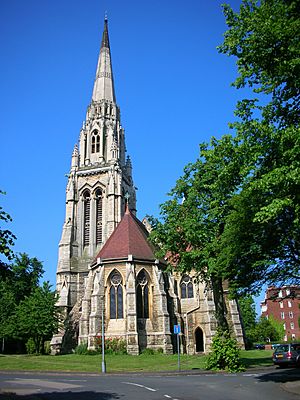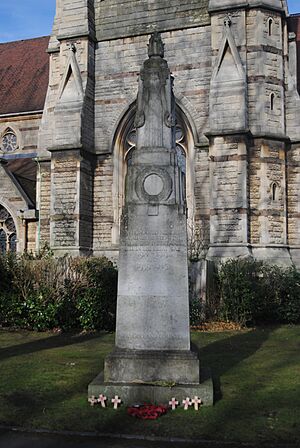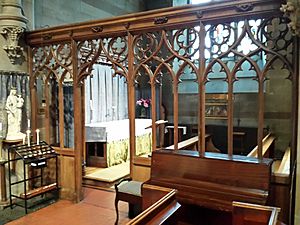St Augustine's Church, Edgbaston facts for kids
Quick facts for kids Church of St Augustine of Hippo, Edgbaston |
|
|---|---|

Parish Church of St Augustine of Hippo, Edgbaston
|
|
| 52°28′24″N 1°56′45″W / 52.4734°N 1.9459°W | |
| Denomination | Church of England |
| Churchmanship | Anglo-Catholicism |
| History | |
| Dedication | St. Augustine of Hippo |
| Administration | |
| Deanery | Warley & Edgbaston |
| Archdeaconry | Birmingham |
| Diocese | Birmingham |
| Province | Canterbury |
The Church of St Augustine of Hippo is a beautiful church located in Lyttelton Road, Edgbaston, Birmingham, England. It's part of the Church of England, which is the main Christian church in England.
Contents
About St Augustine's Church
St Augustine's Church is in the middle of a special area called a conservation area. This means the area is protected because of its history and beauty. It's one of only a few churches in England named after St. Augustine of Hippo. The church is also a Grade II* listed building, which means it's very important historically and architecturally.
Right in the churchyard, you can find the Edgbaston War Memorial. This memorial was put up in 1921 to remember the soldiers who died in World War I. Later, it was updated to also include those who died in World War II.
The Church's History
In the mid-1800s, the area of Edgbaston started to grow with more houses. As more people moved in, there was a need for new churches. Two other churches, St. George's and St James's, were built in the 1830s and 1850s.
In 1864, a rich pen maker named Joseph Gillott lived in Edgbaston. He talked with an architect named J. A. Chatwin about where to build a new church.
After a competition, Chatwin's design was chosen. He suggested building the church on an "island site" near Hagley Road. This spot was perfect because the other churches were getting too small for the 18,000 people living in the area. People raised £9,000 to build the new church, which was a lot of money back then!
The first stone of the church was laid on October 14, 1867. The main part of the church, including the chancel, nave, and aisles, was officially opened on September 12, 1868. The Bishop of Worcester, Mervyn Charles-Edwards, led the special ceremony.
Building the Tower and Special Features
The church's tall tower and spire, which is 185 feet high, were added in 1876. This tower is the tallest in Birmingham! The church was built in a style called Geometric Gothic.
Inside, the church has amazing features:
- A painted ceiling in the chancel that shows a scene from the Book of Revelation.
- Beautiful stained glass windows made by Hardman & Co..
- Lots of stone carvings by John Roddis. These include a large carving behind the altar, called a reredos, which shows the Last Supper like in Leonardo da Vinci's famous painting.
- Unusual carvings on the pillars in the main part of the church (the nave). These carvings show the four seasons and the twelve months of the year!
Later Additions and Changes
Just before World War II, a part of the church under the tower was changed into a Lady chapel. This chapel was given in memory of Benjamin and Elinor Tilley by their daughter, Elinor Mary Incledon. After the war, a special screen was added around the chapel. It was carved by Robert Pancheri in a style called Art Nouveau.
In 1964, a new baptistry was created in the north transept. This was designed by George Pace. A large entrance area, called a narthex, was added in 1968. This was designed by P. B. Chatwin, who was the son of the original architect. It was built to celebrate the church's 100th birthday! The carvings on the font cover and the finials (decorative tops) in the Lady Chapel were made by John Bunting.
The church also has a brass lectern, which is a stand for reading. It's shaped like an eagle and was made by Hardman & Co. when the church first opened. This lectern was stolen in June 2024 but was found and returned a week later!
Past Leaders of the Church
Here are some of the vicars who have led St Augustine's Church over the years:
- 1868-1903 The Reverend J. C. Blissard
- 1903-1912 The Venerable Winfrid Oldfield Burrows
- 1912-1923 The Reverend Dr Rosslyn Bruce
- 1923-1929 The Reverend Canon Arthur Gittins Lloyd
- 1929-1938 The Venerable John Harold Richards
- 1938-1949 The Reverend Canon John Cuthbert Lucas
- 1949-1964 The Reverend Canon Cecil Rhodes
- 1965-1977 The Reverend Philip Llewellyn Richards
- 1978-1985 The Reverend John Maxwell Lucas
- 1986-1999 The Reverend Raymond Franklin Price
- 2000- The Reverend Matthew Tomlinson
Music at St Augustine's
St Augustine's Church is well-known for its amazing choir! It was the first Anglican church in Birmingham to have a choir that wore special robes called surplices. Famous musicians like Alfred Robert Gaul, Sir William Henry Harris, and Harvey J. Stansfield have led the music here.
The famous composer Herbert Howells even wrote a piece of music called 'St Augustine's Service' for the choir in 1967. The choir performed this challenging piece again in October 2013, for only the second time since it was written! You can listen to it online: "St Augustine's Service – 13th October 2013".
The Church Organ
The church has a large organ made by a company called Hill. It has been worked on by other companies like Rothwell and Nicholson. You can find more details about this organ on the National Pipe Organ Register website.
Music Directors
Many talented people have been in charge of music at St Augustine's:
- Alfred Robert Gaul 1868 – 1913
- Sir William Henry Harris 1913 – 1919
- Thomas William North 1919 – 1955
- Philip Moore 1956 – 1960
- Roy Massey 1960 – 1965
- Derek Williams 1965 – 1972
- Philip Godden 1973 – 1975
- Nigel Argust 1975 – 1979
- Norman Dyson 1979 – 1987
- Christopher Harker 1985 – 2004
- Darren Hogg 2004 – 2008
- Paul Richards 2008 – 2012
- Thomas Keogh 2012 to 2015
- Sarah Fox 2016
- David Whitehead 2016 to 2020
- Harvey J. Stansfield 2021-2022
More to Explore
- List of works by George Pace



